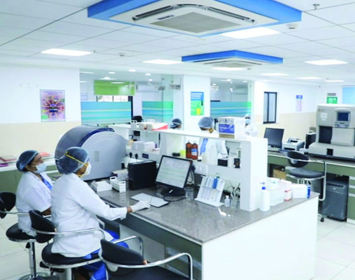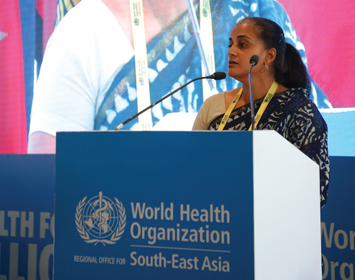Global Health Security
CDC India Director Meghna Desai, second from left, and Dr. Roderico Ofrin (WHO Representative) for India, far left, Dr. SK Jain, Dr. Anil Patil, and Dr. Ashok Kumar Sharma from NCDC gather to celebrate the institution’s 112th Annual Day, 2021. Photo credit: NCDC

CDC developed the first sustainable integrated model for District Public Health Labs, Raipur, Chattisgarh, 2020, Photo credit: CDC India office
In today’s globally connected world, disease threats can spread faster and more unpredictably than ever before. The GOI is building strong and sustainable foundations to respond to current and future threats. As part of Global Health Security Agenda (GHSA) efforts, CDC India works with a range of GOI partners focused on targets for WHO’s International Health Regulations and GHSA. CDC’s global health security collaborations leverage decades of cooperation with GOI, with a focus on core public health capabilities across disease surveillance, laboratory systems, public health workforce, and emergency response.
Surveillance
Over the past decades, CDC worked with GOI to increase disease surveillance capabilities at the national and state levels. This work focused both on disease-specific surveillance programs, and integrated disease surveillance initiatives. In recent years, CDC provided technical support to GOI for enhanced diagnostic testing and real-time reporting of results through India’s National Center for Disease Control (NCDC)/Integrated Disease Surveillance Programme and National Vector Borne Disease Control Programme. CDC also worked with GOI to strengthen Acute Febrile Illness (AFI) and Acute Encephalitis Syndrome (AES) surveillance systems.
Laboratory
CDC has long supported GOI efforts to improve laboratory-based surveillance of infectious diseases by increasing public health laboratory capabilities. This is a critical aspect of global health security efforts in India at the national and state levels. In the past few years, CDC, NCDC and the National Laboratory Task Force worked together to bolster the diagnostic capacities of district public health laboratories in several states, through mapping and comprehensive assessments, hands-on microbiology and biosafety trainings, and a web-based mentoring and monitoring system. These efforts led to the GOI’s nationwide commitment to prioritize and set aside funding to establish Integrated Public Health Laboratories (IPHL) in every district across the country, as part of the GOI’s National Health Mission. The GOI invited CDC to be a part of its national-level expert group focused on public health lab strengthening efforts across the country. This will help implement quality-assured diagnostic testing, streamline specimen transport systems, and improve supply chains.
Public Health Workforce
CDC has collaborated with the Indian government for decades to expand and equip its public health workforce with the skills needed to confront the country’s most critical public health challenges today and in the future. In collaboration with the GOI/ICMR’s National Institute of Epidemiology, CDC launched the first Field Epidemiology Training Program (FETP) in India in 2001. The India EIS training program was expanded in 2016 to include WHO NPSP officers, initially through the advanced India EIS program, and later through an 18-month intermediate training program. FETP efforts expanded again in 2018 with the establishment of a two-year ICMR-NIE in-service training program, which also includes a Noncommunicable Disease (NCD) FETP Fellowship. In the last nine years, 73 officers have completed the two-year India EIS program, including two officers from the more recently established NCD-focused FETP program. CDC India is supporting a third level of FETP in India, through a three-month frontline training program focused on basic epidemiological and outbreak response skills.
Emergency Response
For over a decade, CDC has worked with GOI to enhance emergency response capabilities that are critical for the country’s response to infectious disease and other public health threats. In partnership with the National Centers for Disease Control under the MOHFW and National Disaster Management Authority , CDC emergency response activities are focused on strengthening emergency operations centers (EOC) at the national and state level, development of emergency response plans and standard operating procedures, in-depth and rapid response team training programs, emergency management certification programs for accreditation and credentialing of EOC staff and emergency responders, and real-time support for multiple activations of the national and state-level EOCs and outbreak response systems.
CDC staff helping to set up a field Public Health Emergency Operations Centre with common minimal resources following WHO’s standards, Haridwar, 2021, Photo credit: CDC India office

CDC India Director and Program Director for Division of Global Health Protection, Dr, Meghna Desai, addresses the WHO’s South East Asia Regional Office ministerial roundtable on emergency preparedness in Sep 2019, New Delhi. Photo credit: CDC India office
- Integrated disease surveillance activities in 53 public hospitals in 34 districts of 13 high AFI/AES burden states across India
- Actionable research findings demonstrated that over 85 percent of AFI/AES cases with a diagnosable etiology are due to seven pathogens. These results influenced change in national policy to adopt testing for AFI/AES cases for early diagnosis and better treatment outcomes
- Mapping of more than 350 public and private laboratories, and the launch of the first biosafety cabinet certification program in the country
- Training of more than 10,000 healthcare workers in the lab and field
- Piloting a web-based mentoring and monitoring system for public health district labs across seven states, potentially serving up to 900 million people
- Support for the establishment of India’s first district-level Integrated Public Health Laboratory, developed in the State of Chhattisgarh; the model was adopted by GOI’s National Health Mission for district and subdistrict level healthcare facilities across India
- Played a key technical role in developing the operational guidelines for implementation of Integrated Public Health Laboratories across the country, as a member of the National level Expert Group on IPHL
- India EIS Program graduated 73 officers through the comprehensive two-year training curriculum, with an additional 51 officers in training
- FETP-trained alumni are serving in key leadership roles within GOI at the national and state-government level, embedded within WHO, and serving in prominent academic institutions and non-governmental organizations throughout India
- Most of the India EIS alumni, current officers and other FETP trainees are engaged in COVID-19 response activities across 22 states in India
- CDC supported the national-level strategic health operation center (SHOC) at NCDC in New Delhi, and the development of state-level EOCs in Tamil Nadu and Chattisgarh
- CDC is supporting GOI plans to expand development of EOCs at the district, state, and regional level through direct participation in the GOI’s Emergency Management Technical Advisory Group
- Thirty staff from SHOC completed basic Public Health Emergency Management training
- CDC supported SHOC activation for multiple infectious disease outbreak events, including the Nipah outbreak in Kerala, the Maharashtra flood, Kumbh Mela Response, multi-state Zika outbreak, and COVID-19
CDC partners with GOI to strengthen core public health capabilities and systems that prevent, detect, and respond to emerging infectious diseases. There is a focus on real time disease surveillance, laboratory systems and diagnostics, workforce development, and emergency management.